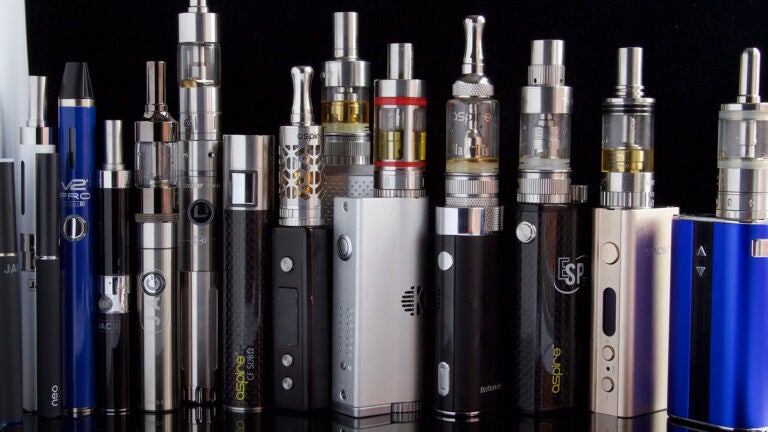
Electronic cigarette users can choose from many different types and flavors of products. (Photo/Jon Williams)
New smoking alternatives gain popularity among teens
The use of e-cigarettes and hookah by adolescents has grown in recent years
After a decades-long fight to highlight the dangers of cigarettes, researchers are growing increasingly concerned about a new slate of alternative products becoming popular among teens.
The use of electronic cigarettes and hookah by adolescents has spiked in recent years, a trend underscored by a new study published in the Journal of Adolescent Health. A hookah is a water pipe used to smoke flavored tobacco.
“You have a group of kids who might have never touched cigarettes given our societal norms that we’ve managed to shift with lots of health education programming and intervention, but now they are using e-cigarettes and hookah,” said Tamika Gilreath, an assistant professor at the USC School of Social Work and lead author of the study.
“Are they going to transition to using other products? Are they going to try cigarettes? Are they going to try cigars?”
The researchers examined data from more than 2,000 high school juniors and seniors in Southern California and found that nearly 11 percent were currently using hookah and nearly 10 percent were using e-cigarettes. Current use of smokeless, dip and chewing tobacco was much lower, at just slightly more than 2 percent.
These figures mirror national findings by the Centers for Disease Control and Prevention, which notes that e-cigarette use tripled among high school students in one year, rising to more than 13 percent of high school students in 2014.
“Is inhaling e-cigarette vapor and hookah long term necessarily healthy?” Gilreath asked. “I may be willing to concede that it is less harmful than cigarettes, but that doesn’t mean it is harmless. We really don’t know what it is doing to these adolescents whose bodies are still developing.”
A new fight
Gilreath is particularly concerned about the social acceptability of e-cigarette and hookah use, given the long battle to turn public opinion against cigarettes.
With tobacco, it took 50 years before we finally agreed this kills people. Now we are back at square one.
Tamika Gilreath
“With tobacco, it took 50 years before we finally agreed this kills people,” she said. “Now we are back at square one.”
Regulations regarding the sale and use of tobacco products like cigarettes and cigars are stringent, but newer alternatives like hookah are largely unregulated in many areas of the country. Some localities have placed restrictions on the sale of e-cigarette liquids and other similar products, but Gilreath said the federal government has to meet a high standard to show that a certain substance is harmful before developing new regulations.
That lack of oversight has allowed a wide variation in nicotine levels and other potentially harmful ingredients in hookah tobacco and e-cigarette products. Gilreath cited research suggesting that one hookah session could be equivalent to smoking between one and 50 cigarettes. Although some nicotine-free versions of e-cig liquids are available, others contain amounts that would be fatal if swallowed.
Sweet science
The lack of regulation has also permitted companies to create flavored products that might be particularly attractive to teens, Gilreath said.
“Hookah and e-cigarettes come in these candy flavors — they can be very sweet,” she said, noting that the federal government stopped the tobacco industry from developing cigarettes with other flavors.
“Menthol was grandfathered in as the only protected flavor,” she added. “But these new products are not covered by those regulations.”
Gilreath’s study found several unique groups of users, including one cluster of teens (mostly boys) that used many forms of tobacco and newer alternatives, including cigarettes, cigars, chewing tobacco, e-cigarettes and hookah. Another group only used hookah and e-cigarettes, but Gilreath expressed concern that they might eventually transition to other tobacco products.
A separate study conducted by researchers at the Keck School of Medicine of USC and published in the Journal of the American Medical Association suggested that using e-cigarettes is associated with a propensity to start using cigarettes or other harmful tobacco products.
The survey of 2,530 14-year-olds at public high schools in Los Angeles revealed that teens who used e-cigarettes were more likely to transition to smokable tobacco, although the researchers cautioned that more studies are needed to determine causality.
Mind the gap
Gilreath is also concerned about racial and ethnic disparities in the use of tobacco and newer products like e-cigarettes. Previous research has indicated that black adolescents are much less likely to smoke cigarettes than their white counterparts, but are disproportionately affected by tobacco use in later life, including higher rates of cancer, emphysema and other chronic conditions.
Advertising for e-cigarettes and other products is highly prevalent in communities of color, she said, describing a preponderance of e-cigarette advertisements in and near her neighborhood of Leimert Park, a middle-class community in South Los Angeles with a large proportion of black residents. She plans to explore patterns of use among teens by race and ethnicity.
“Is there a difference in this e-cig and hookah phenomenon for kids who may be at disproportionate risk for health consequences?” she asked.
Overall, Gilreath is hopeful that research and regulations will catch up with these new products, noting that the Food and Drug Administration and National Cancer Institute recently funded new centers for research on tobacco and related items. Her study was supported by one such center established at USC.
“Let’s do this regulatory science so we can start figuring out what policies we may need to implement to protect people,” she said. “If e-cigarettes are bad, we want to know it as quickly as possible. If they are OK, we need to know that, too.”
